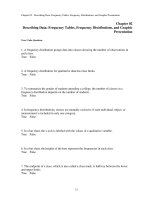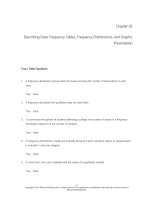Lecture Statistical techniques in business and economics - Chapter 9: Estimation and confidence intervals
Bạn đang xem bản rút gọn của tài liệu. Xem và tải ngay bản đầy đủ của tài liệu tại đây (1.96 MB, 45 trang )
9 1
Estimation and Confidence Intervals
Copyright © 2004 by The McGrawHill Companies, Inc. All rights reserved.
9 2
When you have completed this chapter, you will be able to:
Define a point estimator, a point estimate, and desirable
properties of a point estimator such as
unbiasedness, efficiency, and consistency.
Define an interval estimator and an interval estimate
Define a confidence interval, confidence level, margin of
error, and a confidence interval estimate
Construct a confidence interval for the population mean
when the population standard deviation is known
Copyright © 2004 by The McGrawHill Companies, Inc. All rights reserved.
9 3
Construct a confidence interval for the population variance
when the population is normally distributed
Construct a confidence interval for the population mean
when the population is normally distributed and the
population standard deviation is unknown
Construct a confidence interval for a population proportion
Determine the sample size for attribute and
variable sampling
Copyright © 2004 by The McGrawHill Companies, Inc. All rights reserved.
Terminology
9 4
Point Estimate …is a single value (statistic) used to
estimate a population value (parameter)
Interval Estimate …states the range within which a
population parameter probably lies
Confidence Interval …is a range of values within which
the population parameter
is expected to occur
Copyright © 2004 by The McGrawHill Companies, Inc. All rights reserved.
Desirable properties of a point estimator
9 5
efficient
•• efficient
… possible values are concentrated
close to the value of the parameter
consistent
•• consistent
…values are distributed evenly on
both sides of the value of the
parameter
unbiased
•• unbiased
…unbiased when the expected value equals the value
of the population parameter being estimated.
Otherwise, it is biased!
Copyright © 2004 by The McGrawHill Companies, Inc. All rights reserved.
Terminology
Standard error of the sample mean
Standard error of the sample mean
9 6
…is the standard deviation
of the sampling distribution of the
sample means
x
It is computed by
n
…is the symbol for the standard error of the
sample mean
x
…is the standard deviation of the population
n …is the size of the sample
Copyright © 2004 by The McGrawHill Companies, Inc. All rights reserved.
Standard Error
Standard Error
of the Means
of the Means
is not known and n > 30,
IfIf is not known and n > 30,
the standard deviation of the
the standard deviation of the
sample(ss) is used
) is used
sample(
to approximate the population standard
to approximate the population standard
deviation
deviation
Copyright © 2004 by The McGrawHill Companies, Inc. All rights reserved.
x
Computed by…
s
s
n
9 7
9 8
…that determine the width of a confidence interval
are:
1.
1.
2.
2.
The sample size, n
The sample size, n
The variability in the population,
The variability in the population,
usually estimated by ss
usually estimated by
3. The desired level of confidence
The desired level of confidence
3.
Copyright © 2004 by The McGrawHill Companies, Inc. All rights reserved.
Constructing
Constructing
Confidence Intervals
Confidence Intervals
9 9
IN GENERAL,
A confidence interval for a mean is computed
by:
zα/2
s
n
x
Interpreting…
Interpreting…
Copyright © 2004 by The McGrawHill Companies, Inc. All rights reserved.
Interpreting
Interpreting
Confidence Intervals
Confidence Intervals
9 10
The Globe
Suppose that you read that
“…the average selling price
“…the average selling price
of a family home in
of a family home in
York Region is
York Region is
$200 000 +/ $15000
$200 000 +/ $15000
at 95% confidence!”
at 95% confidence!”
This means…what?
This means…what?
Copyright © 2004 by The McGrawHill Companies, Inc. All rights reserved.
Interpreting
Interpreting
Confidence Intervals
Confidence Intervals
The Globe
“…the average
“…the average
selling price of a
selling price of a
family home in
family home in
York Region is
York Region is
$200 000 +/
$200 000 +/
$15 000 at 95%
$15 000 at 95%
confidence!”
confidence!”
9 11
In statistical terms, this means:
…that we are 95% sure that the
interval estimate obtained
contains the value of the
population mean.
Lower confidence limit is
$185 000 ($200 000 $15 000)
Upper confidence limit is
$215 000 ($200 000 + $15 000)
Copyright © 2004 by The McGrawHill Companies, Inc. All rights reserved.
Also…
Also…
Interpreting
Interpreting
Confidence Intervals
Confidence Intervals
9 12
Your newspaper also reports
that…
You select a random
“…the mean
sample of 36 homes sold
“…the mean
time to sell a
during the past year,
time to sell a
family home
and determine a
family home
in York
90% confidence
in York
Region
interval estimate
Region
is 40 days.
for
is 40 days.
the population mean to
be (3139) days.
Do your sample results support the paper’s claim?
The Globe
Do your sample results support the paper’s claim?
Copyright © 2004 by The McGrawHill Companies, Inc. All rights reserved.
Interpreting
Interpreting
Confidence Intervals
Confidence Intervals
You select a
You select a
random sample
random sample
of 36 homes
of 36 homes
sold during
sold during
the past year,
the past year,
and
and
determine a
determine a
90%
90%
confidence interval
confidence interval
estimate
estimate
for the population
for the population
9 13
Lower confidence limit
is 31 days
Upper confidence limit
is 39 days
Our evidence does not support the
ur evidence does not support the
O
statement made by the newspaper,
statement made by the newspaper,
i.e., the population mean is not 40 days,
i.e., the population mean is not 40 days,
when using a 90% interval estimate
when using a 90% interval estimate
There is a 10% chance (100%90%)
that the interval estimate
does not contain the value
of the population mean!
Copyright © 2004 by The McGrawHill Companies, Inc. All rights reserved.
Interpreting
Interpreting
Confidence Intervals
Confidence Intervals
9 14
90% Confidence Interval
90% Confidence Interval
… 10% chance of falling outside this interval
…or, focus on
tail areas …
i.e. = 0.10
= 0.10
i.e.
.05
.05
90%
31
39
is the probability of a value falling
is the probability of a value falling
outside the confidence interval
outside the confidence interval
Copyright © 2004 by The McGrawHill Companies, Inc. All rights reserved.
9 15
Find the appropriate value of z:
P( X
1
2
z
n
X
z
n
.92
Locate A
Area on
rea on
Locate
the normal curve
the normal curve
Look up a= 0.46 in Table
Look up a= 0.46 in Table
to get the corresponding
to get the corresponding
zscore
zscore
Copyright © 2004 by The McGrawHill Companies, Inc. All rights reserved.
This is a 92%
confidence interval
0.92
1.75 0 1.75
Search in the centre of the
table for the area of 0.46
Z = +/ 1.75
Z = +/ 1.75
Constructing
Confidence Intervals
95% C.I. for
95% C.I. for
the mean:
the mean:
99% C.I. for
99% C.I. for
the mean:
the mean:
x
Common
Common
Confidence
Confidence
Intervals
Intervals
zα/2
s
n
s
X
1.96
X
s
2.58
n
Copyright © 2004 by The McGrawHill Companies, Inc. All rights reserved.
n
9 16
Also, 95% of the
About 95% of
sample means for
the constructed
a specified sample
intervals will
size will lie within
contain the
1.96 standard
parameter being
deviations of the
estimated.
hypothesized
population mean.
Interval Estimates
9 17
If the population
standard deviation is
known or n > 30
If the population
standard deviation is
unknown and n<30
Use the z table…
Use the tttable…
table…
Use the
n
x
Copyright © 2004 by The McGrawHill Companies, Inc. All rights reserved.
x
zα/2
s
tα/2
s
n
More
More
on this
on this
later…
later…
9 18
The Dean of the Business School wants to
estimate the mean number of hours
worked per week by students.
A sample of 49 students
showed a mean of 24 hours
with a standard deviation of 4 hours.
What is the population
mean?
Our best estimate is 24 hours.
Our best estimate is 24 hours.
This is a point estimate.
Copyright © 2004 by The McGrawHill Companies, Inc. All rights reserved.
Find the 95 percent confidence
95 percent confidence
interval for the population mean.
9 19
Commonly denoted as 1
Commonly denoted as 1
s
zα/2 n
Mean = 24 SD = 4 N = 49
Mean = 24 SD = 4 N = 49
Z = +/ 1.96
Z = +/ 1.96
x
95% Confidence
95% Confidence
Substitute
Substitute
24 + 1.96
values:
values:
4
49
= 24 +/
+/ 1.12
1.12
= 24
The Confidence Limits range from 22.88 to 25.12
22.88 to 25.12
The Confidence Limits range from
Copyright © 2004 by The McGrawHill Companies, Inc. All rights reserved.
Interval Estimates
90% confidence level
90% confidence level
1 = 0.9
or = 0.10
99% confidence level
99% confidence level
1 = 0.99
or = 0.010
Copyright © 2004 by The McGrawHill Companies, Inc. All rights reserved.
9 20
Student’s tdistribution
Student’s tdistribution
9 21
….used for small sample sizes
Characteristics
Characteristics
…like z, the tdistribution is continuous
…takes values between –4 and +4
…it is bellshaped and symmetric about zero
…it is more spread out and flatter at the centre
than the zdistribution
…for larger and larger values of degrees of
freedom, the tdistribution becomes closer
and
closer to the standard normal distribution
Copyright © 2004 by The McGrawHill Companies, Inc. All rights reserved.
Student’s tdistribution
Student’s tdistribution
Chart 91
Chart 91
Comparison of The Standard Normal Distribution
Comparison of The Standard Normal Distribution
and the Student’s t t Distribution
Distribution
and the Student’s
The t t distribution should be flatter and more spread out
distribution should be flatter and more spread out
The
than the zz distribution
distribution
than the
t distribution
Copyright © 2004 by The McGrawHill Companies, Inc. All rights reserved.
Z distribution
9 22
Student’s tdistribution
Student’s tdistribution
9 23
…with df = 9 and 0.10 area in the upper tail…
t = 1.383
0.10
t
T table
table
T
Copyright © 2004 by The McGrawHill Companies, Inc. All rights reserved.
Student’s tdistribution
Student’s tdistribution
Confidence Intervals
80% 90% 95% 98% 99%
Level of Significance for OneTailed Test
0.100 0.050 0.025 0.010 0.005
0.10
Level of Significance for TwoTailed Test
0.20 0.10 0.05 0.02 0.01
9
1.383
Copyright © 2004 by The McGrawHill Companies, Inc. All rights reserved.
9 24
When?
When?
9 25
…to use the z Distribution or the t Distribution
Population Normal?
Population Normal?
NO
NO
YES
YES
30 or more?
nn 30 or more?
NO
NO
YES
YES
Population standard
Population standard
deviation known?
deviation known?
NO
NO
Use a
Use a
Use the z
z Use the
Use the tt
Use the
nonparametric
nonparametric
distribution distribution
test
distribution
distribution
test
(see
(see
Copyright © 2004 by The McGrawHill Companies, Inc. All rights reserved.
YES
YES
Use the z
z
Use the
distribution
distribution









